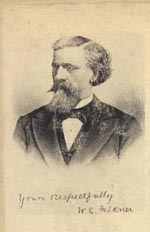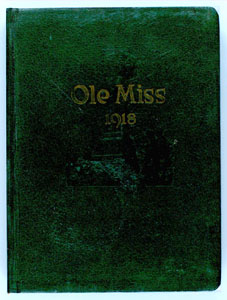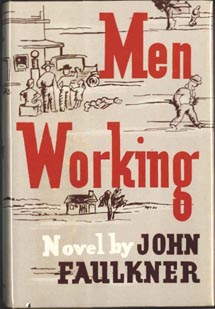
 |
Family and Early Life |
 |
Portrait of William Clark Falkner. Photo reproduction, on the dust jacket for The White Rose of Memphis (New York: Coley Taylor,1953).William Faulkner's great-grandfather was called "Kunnel Falkner." He was a colorful figure whose life was the basis for family legend and pride. As a boy William loved to hear the tales of his exploits during the Civil War. He read his great-grandfather's novels, too, including The Siege of Monterey (1851), The Spanish Heroine (1851), The Lost Diamond (1867), The Little Brick Church (1 882), and Rapid Ramblings in Europe (1884). The White Rose of Memphis(1881) was the elder Falkner's major work, incorporating some of the worst characteristics of melodrama, but also offering good characters in a fast-moving plot of violence, betrayal, and the rewards of true-love. The novel was a great success, remaining in print for nearly three decades and appearing in thirty-five editions that sold approximately 160,000 copies. |
William Clark Falkner (18 25-1889).The White Rose of Memphis. New York: G. W. Carleton & Co., 1953.Although young William Faulkner is reported to have said at age nine, "I want to be a writer like my great-granddaddy," the elder Fal kner's influence was much more pervasive. Born in Tennesse, he left home when he was fourteen, travelling to Ripley, Mississippi, to live with relatives. He soon became involved in writing the life of a convicted ax murderer; fighting in the Mexican War ( 1846-48); establishing himself as a lawyer, husband, and father; killing at least two men in violent arguments; and investing in land and slaves. During the Civil War he was captain of the Magnolia Rifles, then Colonel of the 2nd Mississippi Infantry Regi ment, a hero in the battle of the First Manassas, and finally the founder of the First Mississippi Partisan Rangers who fought valiantly in northeast Mississippi and southern Tennessee. After the War, he built a railroad, was elected to the Mississippi le gislature, and in 1889 was murdered by his one-time business partner whom he had just defeated in the election. Such a life of action, triumph, tragedy, accomplishment, and defeat provided Faulkner with invaluable material for his own writing. Qua lities of W. C. Falkner and his descendants are clearly present in the principal characters and themes of Sartoris and The Unvanquished. |
 |
 |
Faulkner family photographs. In Joseph Blotner's, Faulkner: a Biography (New York: Vintage Books, 1991).The photos reproduced here are those of Faulkner's paternal grandparents, his pa rents, his father's sister, Holland Falkner Wilkins, and, in the separate reproduction, his three brothers, Murry, John, and Dean. These individuals, along with the many others in the extended family, provided a childhood with ample adult authority and co mpanionship from siblings, cousins, and friends. It was a nineteenth-century childhood in a small southern town, largely before the introduction of the automobile. The family continued the success and prosperity that the Old Colonel (W. C. Falkner) had be gun through a combination of activities involving law, railroading, real estate, farming, local and state politics, and a variety of businesses. |
Ole Miss, the Year Book of the University of Mississippi. Vol. XXII (1917-1 8)William Faulkner never graduated from high school. He was at best an indifferent student who managed to endure the Oxford, Mississippi, Public Schools through most of the eleventh grade. But he was a quick and enthusiastic reader, intelligent , imaginative, and sensitive. He was precocious in drawing and painting and had been writing stories and poems since the fourth grade. These talents were the entree for Faulkner to become accepted among his fellow students at the University of Mi ssissippi when he enrolled there as a special student in the fall of 1919. Although he did not take many classes, he was invited into the Sigma Alpha Epsilon fraternity and served as one of the art editors for the school yearbook. |

|

|
John Faulkner (1901-1963). Men Working. New York: Harcourt Brace and Co., 1941.John Wesley Thompson Faulkner, III, was the third of the four Faulkner brothers. He studied engineering at the University of Mississippi, b ut turned to flying in 1931 and became a barnstormer and charter service pilot. When his airplane turned upside-down over Georgia one night, he gave up that career, returned to Oxford, and worked on several Work Projects Administration projects. B esides his relationship to William, he is best remembered for a series of popular novels beginning in 1941 with Men Working. Others include Dollar Cotton (1942), Chooky (1950), and Cabin Road, a five-novel series brought out in paperback between 1951 and 1960. These novels concentrate on the affairs of people living in the hills of northern Mississippi, mostly those similar to the Bundrens, the McCallums, the Snopeses, and the Gowries found in his brother's novels. John Faulkner's knowledge of these people stems largely from the years he managed a farm William had bought in 1938 in the pine hills northeast of Oxford. It was a 320-acre spread located in Beat Two, the toughest part of Lafayette County. John described the people as those who "made their own whisky from their own corn and fought over elections and settled their disputes." |